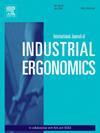Understanding miners' risk decisions: A multimodal analysis of personality, job burnout, and behavioral responses
IF 3
2区 工程技术
Q2 ENGINEERING, INDUSTRIAL
International Journal of Industrial Ergonomics
Pub Date : 2025-05-01
DOI:10.1016/j.ergon.2025.103753
引用次数: 0
Abstract
Background
Human factors contribute to 71 % of coal mining accidents, yet the individual causes of unsafe behaviors, especially decision-making, remain underexplored. Previous studies have shown that personality traits and job burnout significantly impact risk-related decision preferences.
Objective
This study investigates how miners' personality traits influence decision-making under uncertainty through job burnout dimensions, using subjective and objective multimodal data.
Methods
Thirty frontline miners were assessed using personality trait questionnaires and the Maslach Burnout Inventory to classify burnout levels. A Wheel of Fortune gambling experiment under performance pressure was conducted, with eye-tracking technology recording decision behaviors.
Results
Personality traits correlate significantly with burnout dimensions. A neuroticism-based model categorizes miners into NH (high risk, high burnout) and NL (low risk, low burnout) groups. PLS-SEM path analysis identifies three significant paths, while hierarchical regression shows personality traits and burnout predict risk preference (C) under uncertainty. Eye-tracking data reveal the NH group exhibits simpler gaze trajectories, fewer fixations, and less attention to key information under pressure compared to the NL group. Conclusions: Job Burnout mediates the relationship between personality traits and uncertain decision-making performance. Behavioral differences between NH and NL groups highlight the need for personalized safety management. This study provides theoretical and practical insights into emergency behavior under pressure and supports tailored interventions for miner safety.
理解矿工的风险决策:个性、工作倦怠和行为反应的多模态分析
人为因素造成了71%的煤矿事故,但不安全行为的个体原因,特别是决策,仍未得到充分探讨。先前的研究表明,人格特质和工作倦怠显著影响风险相关决策偏好。目的运用主客观多模态数据,通过工作倦怠维度,探讨不确定条件下矿工人格特质对决策的影响。方法采用人格特质问卷和马斯拉克职业倦怠量表对30名一线矿工的职业倦怠水平进行分类。在成绩压力下进行幸运之轮赌博实验,用眼动追踪技术记录决策行为。结果人格特质与职业倦怠各维度显著相关。一个基于神经症的模型将矿工分为NH(高风险、高倦怠)和NL(低风险、低倦怠)两组。PLS-SEM路径分析发现了三条显著路径,层次回归分析显示人格特质和倦怠对不确定性下的风险偏好(C)有预测作用。眼球追踪数据显示,与NL组相比,NH组在压力下表现出更简单的凝视轨迹,更少的注视,对关键信息的关注也更少。结论:工作倦怠在人格特质与不确定决策绩效之间起中介作用。NH组和NL组之间的行为差异突出了个性化安全管理的必要性。该研究为压力下的应急行为提供了理论和实践见解,并为矿工安全提供了量身定制的干预措施。
本文章由计算机程序翻译,如有差异,请以英文原文为准。
求助全文
约1分钟内获得全文
求助全文
来源期刊
CiteScore
6.40
自引率
12.90%
发文量
110
审稿时长
56 days
期刊介绍:
The journal publishes original contributions that add to our understanding of the role of humans in today systems and the interactions thereof with various system components. The journal typically covers the following areas: industrial and occupational ergonomics, design of systems, tools and equipment, human performance measurement and modeling, human productivity, humans in technologically complex systems, and safety. The focus of the articles includes basic theoretical advances, applications, case studies, new methodologies and procedures; and empirical studies.

 求助内容:
求助内容: 应助结果提醒方式:
应助结果提醒方式:


